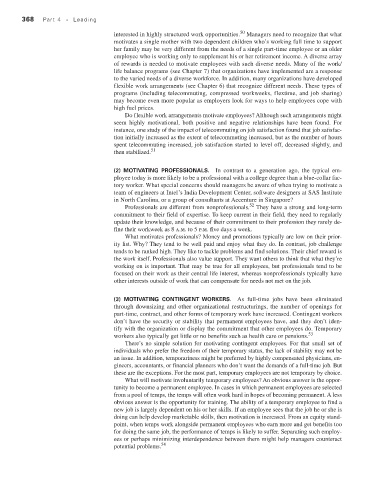Page 369 - Fundamentals of Management Myths Debunked (2017)_Flat
P. 369
368 Part 4 • Leading
50
interested in highly structured work opportunities. Managers need to recognize that what
motivates a single mother with two dependent children who’s working full time to support
her family may be very different from the needs of a single part-time employee or an older
employee who is working only to supplement his or her retirement income. A diverse array
of rewards is needed to motivate employees with such diverse needs. Many of the work/
life balance programs (see Chapter 7) that organizations have implemented are a response
to the varied needs of a diverse workforce. In addition, many organizations have developed
flexible work arrangements (see Chapter 6) that recognize different needs. These types of
programs (including telecommuting, compressed workweeks, flextime, and job sharing)
may become even more popular as employers look for ways to help employees cope with
high fuel prices.
Do flexible work arrangements motivate employees? Although such arrangements might
seem highly motivational, both positive and negative relationships have been found. For
instance, one study of the impact of telecommuting on job satisfaction found that job satisfac-
tion initially increased as the extent of telecommuting increased, but as the number of hours
spent telecommuting increased, job satisfaction started to level off, decreased slightly, and
then stabilized. 51
(2) Motivating Professionals. In contrast to a generation ago, the typical em-
ployee today is more likely to be a professional with a college degree than a blue-collar fac-
tory worker. What special concerns should managers be aware of when trying to motivate a
team of engineers at Intel’s India Development Center, software designers at SAS Institute
in North Carolina, or a group of consultants at Accenture in Singapore?
52
Professionals are different from nonprofessionals. They have a strong and long-term
commitment to their field of expertise. To keep current in their field, they need to regularly
update their knowledge, and because of their commitment to their profession they rarely de-
fine their workweek as 8 a.m. to 5 p.m. five days a week.
What motivates professionals? Money and promotions typically are low on their prior-
ity list. Why? They tend to be well paid and enjoy what they do. In contrast, job challenge
tends to be ranked high. They like to tackle problems and find solutions. Their chief reward is
the work itself. Professionals also value support. They want others to think that what they’re
working on is important. That may be true for all employees, but professionals tend to be
focused on their work as their central life interest, whereas nonprofessionals typically have
other interests outside of work that can compensate for needs not met on the job.
(3) Motivating contingent Workers. As full-time jobs have been eliminated
through downsizing and other organizational restructurings, the number of openings for
part-time, contract, and other forms of temporary work have increased. Contingent workers
don’t have the security or stability that permanent employees have, and they don’t iden-
tify with the organization or display the commitment that other employees do. Temporary
workers also typically get little or no benefits such as health care or pensions. 53
There’s no simple solution for motivating contingent employees. For that small set of
individuals who prefer the freedom of their temporary status, the lack of stability may not be
an issue. In addition, temporariness might be preferred by highly compensated physicians, en-
gineers, accountants, or financial planners who don’t want the demands of a full-time job. But
these are the exceptions. For the most part, temporary employees are not temporary by choice.
What will motivate involuntarily temporary employees? An obvious answer is the oppor-
tunity to become a permanent employee. In cases in which permanent employees are selected
from a pool of temps, the temps will often work hard in hopes of becoming permanent. A less
obvious answer is the opportunity for training. The ability of a temporary employee to find a
new job is largely dependent on his or her skills. If an employee sees that the job he or she is
doing can help develop marketable skills, then motivation is increased. From an equity stand-
point, when temps work alongside permanent employees who earn more and get benefits too
for doing the same job, the performance of temps is likely to suffer. Separating such employ-
ees or perhaps minimizing interdependence between them might help managers counteract
potential problems. 54

